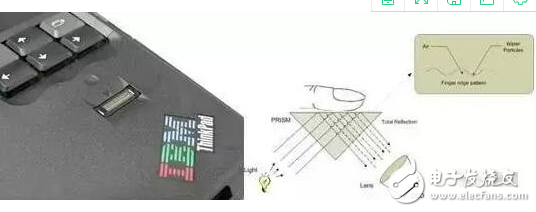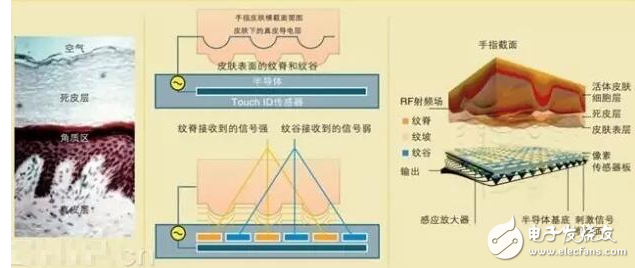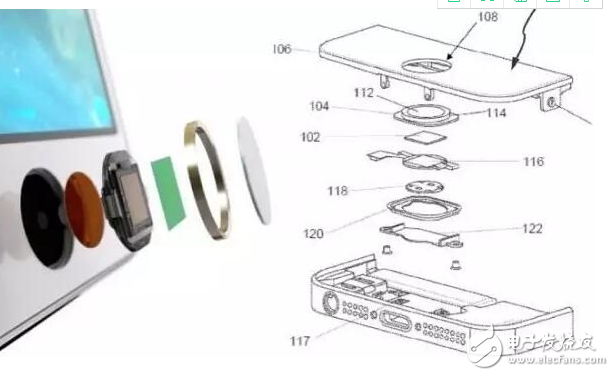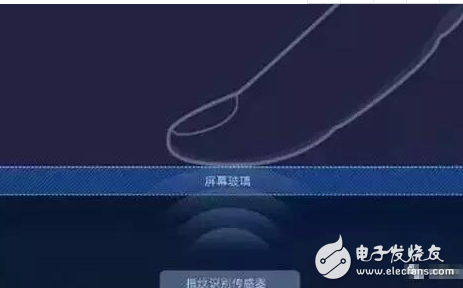Fingerprint recognition technology associates a person with his fingerprint and compares his fingerprint with a pre-saved fingerprint to verify his true identity. Everyone (including fingerprints) has different skin textures in patterns, breakpoints, and intersections. It is unique. With this uniqueness and stability, we can create fingerprint recognition technology. Skin textures, including fingerprints, vary from pattern to pattern to breakpoints and intersections, presenting uniqueness and lifetime.
In terms of application methods, fingerprint recognition technology can be divided into verification and identification.
Verification: The process of determining identity by one-to-one comparison of a fingerprint collected on site with an already registered fingerprint. Fingerprints are stored in a compressed format and are associated with their name or their identification (ID, PIN). Then in the comparison site, the identification is first verified, and then the fingerprint of the system is compared with the fingerprint collected on site to prove that the identification is legal. Verification actually answers the question: "Is he the person he claims to be?" This is the method used in the application system.
Identification: The fingerprints collected on the site are compared with the fingerprints in the fingerprint database one by one, and the fingerprints matching the on-site fingerprints are found out. This is also called "one-to-many match." Identification actually answers the question: "Who is he?" Fingerprints are unique features of the human body and are complex enough to provide features for identification. With the gradual maturity of related support technologies, fingerprint identification technology has become the most convenient, reliable, non-invasive and inexpensive biometric technology solution after years of development, and has great potential for the application of the vast market.
At present, there are mainly four types of fingerprint image acquisition technologies applied in the market: optical scanning devices, temperature difference sensing fingerprint sensors, semiconductor fingerprint sensors, and ultrasonic fingerprint scanning.
First, optical recognition technologyThe use of optical technology to capture fingerprints is the oldest and most widely used technology. Place the finger on the optical lens, and use the prism to project it on the charge coupled device (CCD) under the illumination of the built-in light source, and then form the ridge line (the line with a certain width and direction in the fingerprint image) is black and valley. The lines (recessed portions between the lines) are white, digitized, multi-gray fingerprint images that can be processed by the fingerprint device algorithm.

Optical fingerprint acquisition technology has obvious advantages: it has been tested for a long time, to some extent adapt to temperature variations, can reach a higher resolution of 500 DPI, etc., the most important is low price. There are also obvious disadvantages: due to the requirement for a sufficiently long optical path, a sufficiently large size is required, and excessively dry and excessively greasy fingers will also deteriorate the effect of the optical fingerprint product.
The limitations of optical fingerprint sensing are reflected in the potential fingerprints (potential fingerprints are left after the finger is pressed on the platen), which not only reduces the quality of the fingerprint image, but also may cause two fingerprints to overlap, which is obviously difficult to meet. Practical application needs. In addition, platen coatings and CCD arrays can cause losses over time, which may result in reduced quality of the captured fingerprint image. However, it has disadvantages such as the inability to perform live fingerprint identification and poor applicability to wet and dry fingers.
The optical fingerprint recognition system can only scan the surface of the finger skin or scan the dead skin layer because the light cannot penetrate the surface of the skin (dead skin layer), but it cannot penetrate the dermis layer. In this case, the cleanness of the finger surface directly affects the recognition effect. If there is more dust on the user's finger, an identification error may occur. Moreover, if people follow a finger and make a fingerprint hand model, it is also possible to identify the system, which is not very safe and stable for the user.

The temperature difference sensing technology is based on the principle of temperature sensing. Each pixel is equivalent to a miniaturized charge sensor, which is used to sense the temperature difference between a finger and the chip image area to generate a representative image information. Electrical signal.
It has the advantage that the fingerprint image can be acquired within 0.1 s, and the sensor has the smallest volume and area, that is, the so-called sliding fingerprint reader is currently adopted. The disadvantage is: subject to temperature limitations, the length of time, the finger and the chip are at the same temperature.

In the late 1990s, technologies based on semiconductor silicon capacitance effects matured. The silicon sensor becomes one of the plates of the capacitor, and the finger is the other plate. The capacitance difference between the 嵴 and 峪 of the fingerprint line of the hand is compared with the smooth silicon sensor to form an 8-bit grayscale image.
The capacitive sensor emits an electrical signal that will pass through the surface of the finger and the layer of dead skin, directly to the living layer (dermis layer) of the finger skin, and directly read the fingerprint pattern. Due to the depth of the dermis, the sensor can capture more real data, is not susceptible to dust on the surface of the finger, improve the identification accuracy, and effectively prevent identification errors. Semiconductor fingerprint sensors include semiconductor pressure sensitive sensors, semiconductor temperature sensing sensors, etc. Among them, semiconductor capacitive fingerprint sensors are the most widely used.

The semiconductor capacitive sensor determines the position of the position based on the difference between the size of the capacitance of the fingerprint and the capacitance of the semiconductor capacitive sensing particles. The working process is to pre-charge the capacitive sensing particles on each pixel to a certain reference voltage.
When the finger touches the fingerprint representation of the semiconductor capacitor, since the 嵴 is convex and the 峪 is concave, according to the relationship between the capacitance value and the distance, different capacitance values ​​are formed at the 嵴 and 峪. The discharge is then performed using a discharge current. Since the capacitance values ​​corresponding to 嵴 and 峪 are different, the speed of discharge is also different.
The pixels under the arm (high capacitance) discharge slowly, while the pixels under the arm (low capacitance) discharge faster. Depending on the discharge rate, the positions of 嵴 and 峪 can be detected to form fingerprint image data.
Unlike optical devices, which use manual adjustment to improve image quality, the capacitive sensor uses automatic control technology to adjust the fingerprint image pixels and the sensitivity of the local range of the fingerprints, and combines the feedback information to generate high-quality images in different environments. Due to the local adjustment capability, even images with poor contrast (such as areas where the finger is pressed lightly) can be effectively detected, and the sensitivity is increased for these pixels at the capture instant to generate a high quality fingerprint image.

Semiconductor capacitor fingerprint sensors have the advantages of good image quality, generally no distortion, small size, and easy integration in various devices. The electronic signal emitted by it will pass through the surface of the finger and the layer of dead skin, reaching the living layer (dermis layer) of the finger skin, and directly reading the fingerprint pattern, thereby greatly improving the safety of the system.
The most important advantage of semiconductor silicon sensing technology is the ability to achieve live fingerprint recognition. Better image quality than optical technology can be achieved on smaller surfaces, with resolutions of 200-300 lines on a 1cm & TImes; 1.5cm surface (smaller surfaces also result in cost reductions and can be integrated into more Small device). Small size, low cost, high imaging accuracy, and low power consumption make it ideal for use in security and high-end consumer electronics. It is called the second generation fingerprint recognition technology after optics.
Fourth, ultrasonic recognition technologyUltrasonic fingerprint acquisition is a new type of technology. Its principle is to use ultrasonic waves to have the ability to penetrate materials, and to produce echoes of different sizes depending on the material (the ultrasonic waves are absorbed, penetrated and reflected differently when they reach different material surfaces). ). Therefore, by using the difference in skin impedance between the skin and the air, it is possible to distinguish the position where the fingerprint is located.
The ultrasonic frequency used by the ultrasonic technology is 1 & TImes; 104 Hz-1 & TImes; 109 Hz, and the energy is controlled to the extent that it is not destructive to the human body (same as the medical diagnosis). Ultrasonic technology products can achieve the best precision. It requires less cleaning of fingers and planes, but its acquisition time will be significantly longer than the above two types of products, and it is expensive and cannot achieve live fingerprint recognition. Use is rare.

Fingerprint recognition technology is the mainstream technology of biometrics technology, and is the mainstream technology of identity authentication. It has been widely used in various industries. Now with the fingerprint function device, there must be a physical button for you to scan a fingerprint, but with the development of touch and display chips, highly integrated, the future development trend is any location, we can complete fingerprint recognition on the screen . Embedded fingerprint recognition appears at the core, so any restrictions do not affect the equipment manufacturer's industrially designed equipment. As the integration of fingerprint recognition and touch display technology becomes more and more mature, it will become more and more extensive, for example, fast payment, identification, personalized preference customization, etc., and it is likely to replace the password with fingerprint recognition technology.
Multi-Function Electric Blender
Multi-Function Electric Blender,High Speed Blender,Heating Cooking Blender,Cooking Blender For Home
Shandong Sangle Group Co.,Ltd. , https://www.sangle-group.com
![<?echo $_SERVER['SERVER_NAME'];?>](/template/twentyseventeen/skin/images/header.jpg)